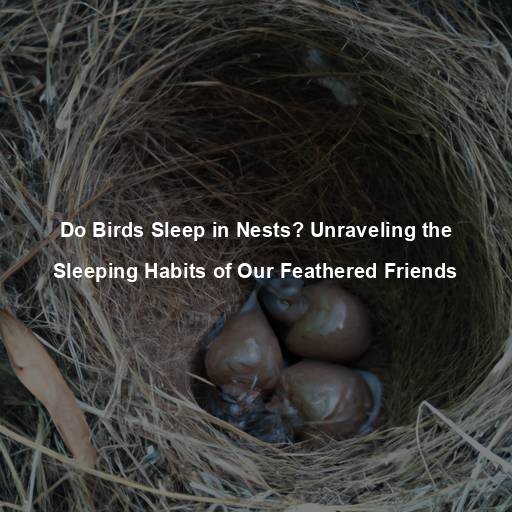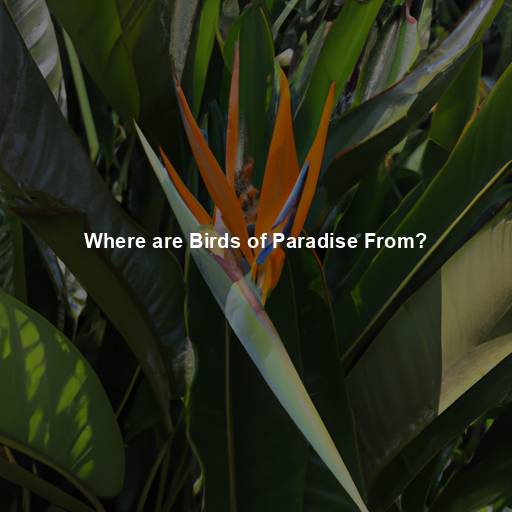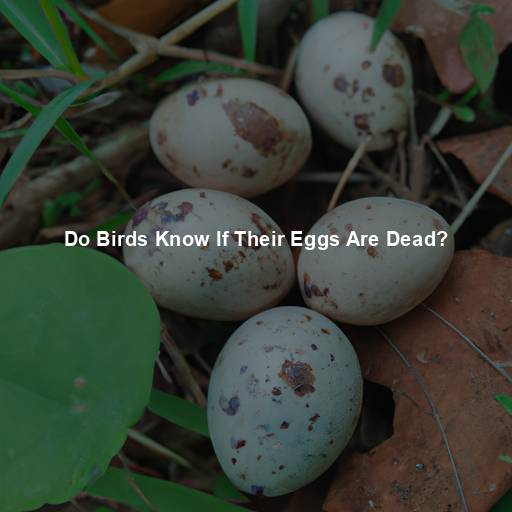Do Birds Sleep in Nests? Unraveling the Sleeping Habits of Our Feathered Friends
Last Updated on July 12, 2023 by Evan
Contents [hide]
- 1 Exploring the Fascinating World of Avian Sleep Patterns
- 1.1 The Nest: A Safe Haven for Many Birds
- 1.2 Sleeping in Nests: A Common Practice
- 1.3 The Benefits of Nest Sleeping
- 1.4 Nocturnal Nest Abandonment
- 1.5 Adaptations for Sleeping in Nests
- 1.6 The Role of Age and Maturity
- 1.7 Avian Siesta: Midday Napping
- 1.8 Perching for the Night
- 1.9 Roosting in Tree Cavities
- 1.10 Ground Dwellers: Birds that Sleep on the Earth
- 1.11 Hidden in Plain Sight: Camouflaged Sleepers
- 1.12 The Sky’s the Limit: Birds that Sleep in Flight
- 1.13 Group Slumber: Safety in Numbers
- 1.14 The Impact of Environmental Factors
- 1.15 The Wonders of Avian Sleep
- 2 Unraveling the Mysteries of Avian Slumber
- 2.1 Rest and Rejuvenation: The Physical Benefits of Sleep
- 2.2 Cognitive Consolidation: The Mental Benefits of Sleep
- 2.3 Feather Maintenance: A Nightly Ritual
- 2.4 Sleep and Predator Avoidance
- 2.5 Adaptations for Safe Slumber
- 2.6 Sleep Duration and Variations
- 2.7 Environmental Influences on Avian Sleep
- 2.8 Sleep Deprivation in Birds
- 3 Unlocking the Mysteries of Avian Sleep
- 4 FAQs: Do Birds Sleep in Nests
- 4.1 Can birds sleep in nests during the night?
- 4.2 Do all birds build nests to sleep in?
- 4.3 What materials are used to construct bird nests for sleeping?
- 4.4 How do birds choose their nesting sites for sleeping?
- 4.5 Do birds return to the same nest to sleep every night?
- 4.6 Do birds only sleep in nests during nighttime?
- 4.7 Do all birds build their own nests or use existing ones?
- 4.8 How long do birds typically sleep in their nests?
Exploring the Fascinating World of Avian Sleep Patterns
Birds, with their vibrant plumage and melodic songs, have always captured our fascination. We often find ourselves wondering about their daily activities, including where and how they rest. One burning question that has intrigued bird enthusiasts and researchers alike is, “Do birds sleep in nests”? To unravel this mystery, we must delve into the captivating world of avian sleep patterns and understand the diverse ways in which our feathered friends find respite.
The Nest: A Safe Haven for Many Birds
When the sun sets and the sky darkens, birds find solace in their secret havens, their nests. These intricately crafted wonders encompass the essence of comfort, deliberately constructed with nature’s bounty. Within these woven abodes, birds find respite from the unpredictable perils of the outside world, a shield against predators and the relentless elements. So as dusk falls and avian beings retire to their sanctuaries, they can truly embrace the calm of the night, nestled snugly in their own woven dreams.
Sleeping in Nests: A Common Practice
Birds, like us, find solace in their nests after an eventful day of soaring through the skies and hopping from branch to branch. These cozy abodes offer them a much-needed reprieve, where they can snuggle into a peaceful slumber. With a sense of security and a touch of familiarity, these nests become their version of a comfortable bed, just like ours.
The Benefits of Nest Sleeping
Sleeping in nests offers several benefits for birds. Firstly, it helps conserve energy by providing a sheltered spot where they can lower their metabolic rate and relax their muscles. This energy conservation is crucial for birds, especially during periods of migration or when food sources are scarce. Nests also act as insulators, providing warmth during chilly nights and protecting birds from the elements.
Nocturnal Nest Abandonment
There’s an intriguing twist to the sleeping habits of certain avian species that usually find solace in their cozy nests. Surprisingly, some of these feathered beings opt to abandon their sanctuaries under the cover of night. This peculiar behavior seems to be more prevalent among cavity-nesting birds, like the resourceful woodpeckers and the enigmatic owls. During daylight hours, they may retreat to their trusty nests, only to venture out into the mysterious realm of alternative roosting sites after sundown.
Adaptations for Sleeping in Nests
In the realm of avian bedtime routines, the wonders never cease to amaze. Take, for instance, the peculiar ability of birds to engage in a one-eyed slumber dance. Yes, you heard that right! These avian maestros have honed their slumber skills to perfection, keeping one eye wide awake while the other indulges in sweet dreams.
The Role of Age and Maturity
As birds embark on their journey of growth and development, their slumber patterns undergo intriguing transformations. In the tender stages of their lives, these exquisite creatures devote ample time to dozing within the snug confines of their nests, distinct from their adult counterparts. This exquisite siesta is not without purpose, for it plays a paramount role in nurturing their blossoming bodies and minds. As they soar towards maturity, these youthful avians slowly embrace the art of slumbering beyond their nests, gracefully perching on branches or scouting out other ideal resting spots, progressively asserting their autonomy and mastering the fine art of independent sleep.
Avian Siesta: Midday Napping
Apart from sleeping at night, birds also engage in short bouts of midday napping. These siestas help birds conserve energy during the hottest hours of the day when foraging may be less productive. Midday napping can be observed in various bird species, from small songbirds to larger raptors. During these brief respites, birds often perch on branches or other elevated spots, remaining alert to any potential threats while dozing off intermittently.
Perching for the Night
When it comes to catching up on their beauty sleep, our feathered friends have quite the peculiar preference: perching. Whether it’s the enchanting melodies of songbirds or the majestic presence of raptors, these avian creatures have taken a liking to spending their nights perched atop branches, shrubs, or any towering structure they can find. Not only does this choice grant them the luxury of saving energy, but it also keeps them on their toes, ever-vigilant for any potential threats that lurk in the darkness. Equipped with their impressive talons and a clever system of tendons, they ensure a secure grip that ensures they won’t be plummeting to the ground mid-slumber.
Roosting in Tree Cavities
When night falls, the avian world embarks on a curious journey, seeking refuge in the most unexpected of places. Hollowed havens nestled amidst the branches, known as tree cavities, become the sanctuaries for a diverse array of cavity-nesting birds. In this mysterious realm, where woodpeckers tap out their lullabies and owls cloak themselves in darkness, the air buzzes with the whispers of feathered creatures finding solace in nature’s architectural marvels. These cozy nooks provide a safe haven from lurking predators and the unpredictable elements, granting these avian travelers a tranquil respite amidst the perplexities of their winged existence.
Ground Dwellers: Birds that Sleep on the Earth
Believe it or not, some birds choose to sleep on the ground rather than in trees or nests. Shorebirds, such as sandpipers and plovers, often hunker down on sandy beaches or in grassy areas for their nightly slumber. These birds have adapted to sleeping in open spaces, relying on their camouflage and vigilance to stay safe from predators while they rest.
Hidden in Plain Sight: Camouflaged Sleepers
There is an astonishing world of avian camouflage that often leaves us perplexed and in awe. Take nightjars and frogmouths, for instance, with their cunning feather patterns that effortlessly blend with their surroundings, transforming them into elusive specters, both in broad daylight and moonlit nights. These feathered masters of disguise have unlocked the secret to peaceful slumber, cloaked by nature’s invisible armor, evading even the most discerning eyes. We find ourselves bursting with curiosity as we delve deeper into the mesmerizing myriad of hidden wonders the avian world has to offer.
The Sky’s the Limit: Birds that Sleep in Flight
Prepare to have your mind blown! It’s time to delve into the mysterious world of avian sleep, where the rules of slumber are turned on their heads. Brace yourself for a tale of birds defying gravity, as they find a way to snooze mid-air. Swifts and select species of seabirds have unlocked the secret to in-flight hibernation, a mind-boggling phenomenon where they can actually rest one side of their brain while fluttering through the atmosphere.
Group Slumber: Safety in Numbers
In some bird species, communal sleeping is the norm. Birds like pigeons, crows, and some waterfowl gather in large flocks to sleep together. This behavior provides safety in numbers, as there are more eyes to spot potential predators and more individuals to sound the alarm if danger arises. Communal sleeping also helps birds regulate their body temperature during colder nights through huddling together for warmth.
The Impact of Environmental Factors
If you think birds have a simple snooze routine, think again! These feathered creatures have sleeping habits that will leave you in awe. From migratory birds adjusting their shut-eye schedules with the seasons to urbanization pushing them to unconventional sleeping spots, it’s a world of perplexity and adaptation. As their natural habitats dwindle, birds may find themselves catching some Z’s in unexpected places like tall buildings or sturdy bridges.
The Wonders of Avian Sleep
Birds, with their astonishing array of species, exhibit an intriguing range of slumbering strategies. Whether it’s comfortably nestled in a cozy nest, safely perched on a precarious branch, or even snoozing on the bare ground, these feathered beings have cleverly tailored their sleeping routines to thrive in their respective environments. Delving into the mesmerizing realm of avian rest not only broadens our comprehension of these extraordinary creatures, but also serves as a captivating tribute to the boundless diversity and resilience embedded within the intricate fabric of the animal realm.
Unraveling the Mysteries of Avian Slumber
As we’ve delved into the mysteries of avian sleep patterns, we have uncovered a fascinating tapestry of diversity and versatility. From cozy nests to unconventional perches, birds have devised ingenious ways to catch some shut-eye. Surprisingly, some birds even manage to doze off mid-flight or blend seamlessly into their surroundings for a hidden siesta. The complex interplay of environmental influences, migratory behavior, and evolving habitats further adds to the enigma of avian sleep habits.
Understanding these sleeping patterns not only deepens our appreciation for the intricacies of avian life but also helps us protect and preserve their habitats. As we continue to unravel the mysteries of avian slumber, let us marvel at the wonders of nature and strive to safeguard the habitats that provide these remarkable creatures with a safe and restful place to sleep. ## The Role of Sleep in the Avian World: Unveiling the Secrets
As we turn our gaze towards the enigmatic world of avian slumber, a captivating conundrum comes to light: What drives birds to seek rest? Venture with us as we unravel the mysteries surrounding the purpose and importance of sleep in the complex tapestry of our feathery companions’ existence.
Rest and Rejuvenation: The Physical Benefits of Sleep
Similar to humans, birds require sleep to restore their physical well-being. During sleep, birds experience physiological processes that promote tissue repair, muscle growth, and immune system maintenance. Restful slumber allows their bodies to recover from the demands of daily activities, ensuring they remain in optimal health.
Cognitive Consolidation: The Mental Benefits of Sleep
When it comes to cognitive functioning, sleep is the unsung hero. From memory enhancement to knowledge absorption, restful slumber works its magic. And it turns out our avian friends rely on the same sleep-induced wizardry. Yes, birds too count on their snooze time to cement their new experiences, be it singing a melodious tune or finding their way back home.
Feather Maintenance: A Nightly Ritual
Feathers are a vital lifeline for our avian friends, offering them the means to traverse the skies, protect themselves from the elements, and put on captivating displays of color. To maintain their feathered arsenal in peak performance, birds dedicate themselves to the art of preening, a meticulous routine encompassing cleaning, arranging, and even nurturing their feathers with a touch of natural oil. These feathery rituals, intriguingly, are not just a daytime affair; birds embrace the perplexing habit of engaging in preening right before they surrender to slumber, ensuring that their divine plumage remains in unparalleled condition and guarantees them a toasty repose.
Sleep and Predator Avoidance
Sleeping is a vulnerable state for any creature, and birds are no exception. However, they have evolved various strategies to minimize the risk of predation while they sleep. Some birds, such as ducks and geese, adopt a “guardian” system, where some individuals remain awake and alert while others sleep. This collective vigilance ensures the safety of the entire group, as potential threats can be detected and responded to quickly.
Adaptations for Safe Slumber
Birds possess incredible adaptations that truly boggle the mind when it comes to their sleep habits. Take unihemispheric sleep, for example. Many species have mastered the art of snoozing with one eye open, allowing them to stay alert even while catching some Zs. And let’s not forget about those stealthy owls.
Sleep Duration and Variations
The fascinating world of avian slumber unveils itself in a gorgeously diverse tapestry of sleep durations. From the majestic soaring prey to the petite fluffballs of song, each bird’s nightly respite is a dance of enigmatic proportions. Species, like enigmatic envoys, carry the torch of variation, with some preferring the indulgence of hours on end, while others savor brief moments of shut-eye, especially during their grand journeys through the skies or romantic rendezvous during the breeding seasons. As the sun graces the horizon, the feathered beings divide into two camps, with the nocturnal souls embracing an extended siesta during the day, adding to the mystique.
Environmental Influences on Avian Sleep
Birds, fascinating creatures of the sky, possess a remarkable ability to adapt their sleep schedules in response to their ever-changing surroundings. Environmental stimuli, like light intensity, ambient temperature, and even noise levels, play a crucial role in influencing when and where our feathered friends decide to catch some Z’s. While most bird species are naturally inclined to sleep during the night, following the rhythmic dance of the sun, certain circumstances, such as extended daylight periods or the intrusion of artificial lighting, can throw their sleep-wake cycles into disarray. Such disruptions may have unforeseen consequences for their overall health and harmony with nature.
Sleep Deprivation in Birds
Birds, those feathery wonders of the sky, seem to share something in common with us humans: the toll of sleep deprivation. Remarkable research has unveiled a curious truth – the absence of proper slumber can befuddle even the most sharp-witted birds. Not only does it dull their cognitive capabilities, but it also takes a jab at their immune system and even sabotages their quest for love, interfering with their reproductive success. It turns out that disruptions to their sleep routine, such as the racket of noise pollution or unsettling disturbances to their cozy nesting sites, can leave our avian friends vulnerable to a bewitching state of sleep deprivation, casting a dark cloud over their health and, in turn, their very survival.
Unlocking the Mysteries of Avian Sleep
As we unravel the secrets of avian sleep, we gain a deeper understanding of the profound importance of rest in the lives of our feathered companions. Sleep serves as a vital physiological and cognitive process, allowing birds to rejuvenate, consolidate memories, and maintain their physical and mental well-being.
As we delve into the intricate world of avian sleep, we uncover a tapestry of adaptations, behaviors, and environmental factors that shape their slumber. Through this journey, we gain a deeper appreciation for our feathered friends and their mysterious sleep patterns. By understanding and valuing the impact of sleep on these captivating creatures, we can create habitats that foster their innate need for restful nights. So let us embark on this captivating exploration, where wonder and perplexity intertwine, unraveling the secrets of avian sleep.
FAQs: Do Birds Sleep in Nests
Can birds sleep in nests during the night?
Birds have long been known to seek refuge in their cozy nests once darkness falls. It’s a sanctuary where they can unwind and recharge, free from the lurking dangers of their surroundings. While nests offer a sense of security and a snug haven from chilly nights, it’s essential to acknowledge that not all feathered friends follow this conventional slumber routine. Some cunning species opt for branch perches or secret hideaways, adding an element of unpredictability to their nocturnal escapades.
Do all birds build nests to sleep in?
It’s a fascinating world out there when it comes to our feathered friends and their snoozing habits. While nest-building is a well-known phenomenon, not all birds jump on the bandwagon. Some avian rebels opt for unconventional slumber spots, adding an element of surprise and intrigue to their sleepy routines. From branch-dwelling daredevils to cozy cavity hunters, the realm of avian sleep is filled with boundless diversity and unexpected choices.
What materials are used to construct bird nests for sleeping?
Building a safe and cozy retreat in the midst of nature’s chaos is no easy feat for our feathered friends. Every bird species, guided by instinct and adroit adaptation, skillfully piece together a puzzle of life-sustaining materials. Whether it be the elegant twigs of resilience, the delicate embrace of leaves and grass, the comforting warmth of moss and feathers, or the unexpected incorporation of fur and small branches, their architectural ingenuity astonishes us. Bursting with resourcefulness, these avian architects create a haven that seamlessly integrates with the whims of their habitats, leaving us in awe of their perplexing feats.
How do birds choose their nesting sites for sleeping?
When it comes to building their cozy abodes, birds have a knack for choosing the goldilocks of nesting sites. From the tip of their beaks, they meticulously evaluate a plethora of factors that would make any real estate agent’s head spin. The availability of scrumptious dining options close by, the constant threat of lurking predators, and the ease of access to the chosen nesting spot are all key players in their high-stakes decision-making process. By carefully selecting these safe havens, our feathered friends not only secure their own peace of mind but also pave the way for a successful brood rearing session.
Do birds return to the same nest to sleep every night?
Many bird species do return to the same nest to sleep every night, particularly during the breeding season. This behavior allows them to establish a familiar and safe space for resting and raising their young. However, not all species exhibit this behavior, as some birds may choose different sleeping locations each night, especially during migration or when their nesting season is over.
Do birds only sleep in nests during nighttime?
Birds generally sleep in nests during nighttime when they are less active and require rest. However, they may also use nests for daytime napping or short periods of rest throughout the day. Outside of these resting periods, birds are usually busy foraging, defending territories, or engaging in other activities necessary for their survival.
Do all birds build their own nests or use existing ones?
In the fascinating world of avian architecture, the diversity of nest-building strategies never ceases to astonish. While some feathered architects tirelessly construct their own intricate abodes, others show a resourcefulness that borders on ingenious. Imagine, if you will, the audacity of certain birds who boldly repurpose abandoned nests, fashioning them into cozy retreats with just the right touch of personalization. And let us not forget the hole-dwellers, those clever cavity-nesters who skip the construction phase altogether, opting to take up residence in ready-made tree crevices or perfectly positioned artificial nest boxes. Such marvels of adaptability and ingenuity make us marvel at the intricate tapestry of nature.
How long do birds typically sleep in their nests?
The amount of time birds spend sleeping in their nests can vary depending on factors such as the bird species and environmental conditions. On average, birds tend to sleep for several hours each night, usually during the darkest hours when they are less vulnerable to predators. However, the exact duration of their sleep can differ among species and might also change depending on the stage of their nesting cycle.







